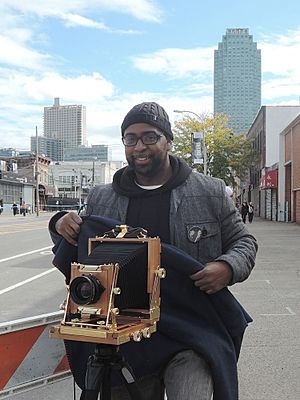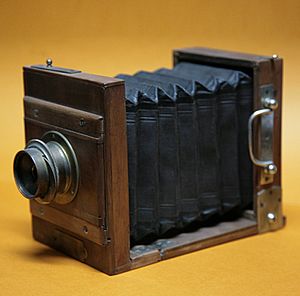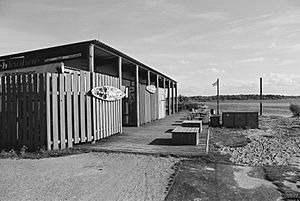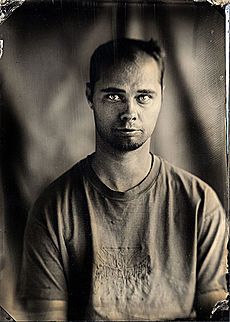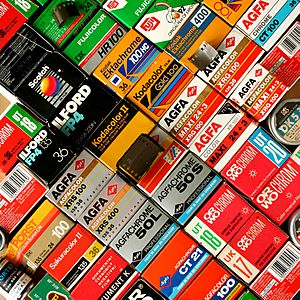Analog photography facts for kids
Analog photography, also called film photography, is a way of taking pictures using special chemical processes. Instead of digital files, images are captured on film, paper, or metal plates. For over 100 years, this was the only way to take photos before digital photography came along. Digital cameras use electronic sensors to save pictures to digital media.
Film cameras use a special coating called photographic emulsion. When light hits tiny silver halide crystals in this coating, it creates a hidden image. This image then goes through a chemical process to become visible and permanent.
Many people thought digital cameras would end film photography. But analog photography didn't just survive; it grew around the world! New groups like Film Is Not Dead and Lomography started. New products also helped keep film photography alive. In 2017, a big camera store called BH Photo & Video said film sales were growing by 5% each year. Some news reports even said young photographers in Japan were leading a movement to save film.
Contents
The Comeback of Film Photography
When digital photography became popular, many big film companies faced problems. In 2004, Kodak stopped making traditional film cameras in North America and Europe. Nikon also stopped making most of its film cameras in 2006. Konica Minolta and Polaroid (famous for instant film) also stopped making film products around that time.
But interest in film photography has been growing again! The Lomography movement started in 1992. It helped save film from disappearing, according to the BBC. Lomography began making new versions of fun, simple cameras. These included the Lomo LC-A, Diana, Holga, Smena, and Lubitel.
Film photographers also started trying old and unique ways to take pictures. These include cyanotypes (blue prints), double exposures (two pictures on one frame), pinholes (cameras without lenses), and redscales (film loaded backward for red colors). There's even a Worldwide Pinhole Photography Day every year in April.
Why Film is Popular
Many online groups have formed for people who love traditional photography. Film photography has become very popular with younger people. They are interested in these older ways of taking pictures. Sales of film cameras have gone up. Young photographers often say film photos have more "soul" than digital ones. Camera makers have noticed this trend. They have started making new, simple point-and-shoot film cameras for beginners.
Polaroid was once a leader in instant film photography. When digital cameras arrived, Polaroid stopped making instant film in 2008. But a new company called Impossible Project (now Polaroid again) bought Polaroid's old machines. They now make new instant films for vintage Polaroid cameras. This has brought Polaroid film back to life!
Film as Art
The return of analog photography has led to new art forms and photo challenges. The limits of film can inspire creativity. For example, in "36 frames challenges," photographers use one roll of film (usually 36 pictures) to capture a specific event or time. This also helps them improve their photography skills.
In contact sheet photography, the traditional contact sheet becomes the artwork itself. A contact sheet shows all the pictures from a roll of film as small images. Artists use this to create a larger picture made of many smaller ones. The black borders of the film divide the image into squares.
Pros and Cons of Film Photography
Advantages
- Taking film photos takes time and effort. This helps photographers learn patience and skill.
- Film can capture a wide range of light and dark details. This depends on the film's sensitivity.
- A film photo that hasn't been changed can sometimes be used as legal proof.
- If stored and developed correctly, a film negative can last a very long time.
Disadvantages
- Film photography needs more time and skill from the photographer than digital.
- Film is delicate. It needs careful handling, cool storage, and protection from sun and dust.
- Film negatives need proper developing. If not, they can get damaged, like fogging.
- Developing film can be expensive. You might also need to pay for scanning, enlarging, or printing.
What You Need for Film Photography
Film photography is more than just film and chemicals. It's a science and a craft. Changing the chemicals or how long you develop the film can change the final picture. An example is tintype photography. A tintype is a positive photo made on a thin, black metal plate. It uses a special chemical solution applied right before the picture is taken. Tintypes became popular in the mid-1800s. They were like an older method called ambrotypes, which used glass instead of metal.
Instant film develops the picture automatically. It comes out of the camera ready to see, without needing a darkroom. But regular Photographic paper must be developed in a darkroom or photo lab after you take the picture.
How Film is Processed
Black-and-white negative film can be processed in different ways. The chemicals and developing time can change the contrast or grain of the picture. Many old black-and-white developing chemicals are not sold anymore. But you can still mix your own using old recipes. Color negative film uses a process called C-41 process. Color slide film uses the E-6 process.
Some photographers also experiment with "cross processing." This means developing slide film with negative chemicals, or vice versa. It often creates unusual colors and high contrast. For a more eco-friendly approach, black-and-white film can even be processed at home using plant-based chemicals.
Film processing does not use digital technology. The information is not turned into electronic signals or computer data.
Types of Film
Films come in different types:
- Daylight film: Used for taking pictures in natural light. Available as negative or slide film.
- Tungsten film: Used for taking pictures under artificial light, like indoor lamps. Available as negative or slide film.
- Infrared film: Mostly for black-and-white photos. It captures light that humans can't see.
Film comes in various sizes, some still used today:
- 110 film: A small roll in a plastic case.
- 135 film: Also known as 35mm, a common roll in a metal can.
- 120 film: A larger roll, often used for medium format cameras.
- Large format: Big sheets of film, like 4x5 inches or 8x10 inches.
- Super 8 film: A small film roll in a plastic case, often used for home movies.
- Cinema film: Larger rolls like 16mm or 35mm, used for professional movies.
Many black-and-white films are still made today, including:
- ADOX CHS 100 II
- FOMA FOMAPAN 100 Classic
- FujiFilm Neopan Acros 100
- Ilford Pan F Plus 50
- Ilford HP5 Plus 400
- Kodak T-MAX 100
- Kodak TRI-X 400
Many color films (mostly 35mm and 120 formats) are also sold, such as:
- Fujichrome Velvia 50
- Kodak Ektachrome 100
- Kodak Portra 160 Professional
- Kodak Color Plus 200
- Fujifilm Pro 400 H
- Cinestill Daylight 50
See also
 In Spanish: Fotograf%C3%ADa anal%C3%B3gica para ni%C3%B1os
In Spanish: Fotograf%C3%ADa anal%C3%B3gica para ni%C3%B1os
- Analog signal
- Digitization
- Digital photography


